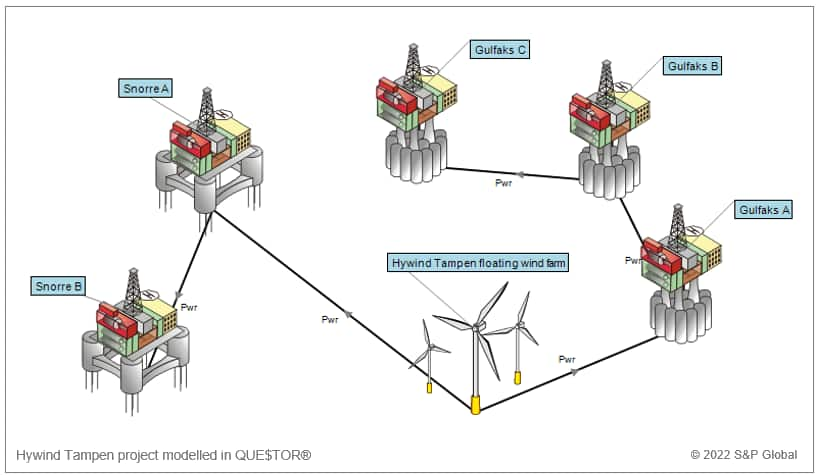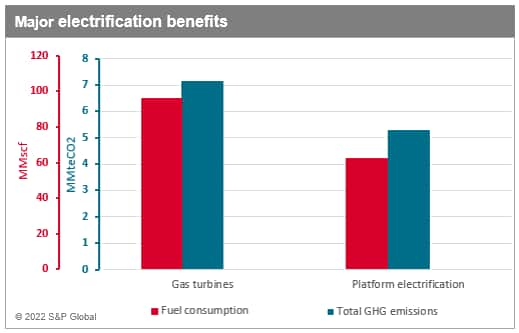Platform electrification as a first step towards renewable energy integration
A more integrated offshore energy sector, with closer links between oil and gas and offshore renewables is vital to accelerate the energy transition. S&P Global's cost estimation software QUE$TOR® offers the capability to model offshore floating wind farms to estimate CAPEX, OPEX, and Decommissioning costs of platform electrification projects with offshore wind energy integration.
Climate change is one of the greatest challenges facing our times. As the energy sector is the largest contributor to global greenhouse gas (GHG) emissions (1), energy integration with renewable sources plays a key role in reducing the carbon footprint of oil and gas operations in the coming decades. In the UK Continental Shelf (UKCS), about 70% (2) of the GHG emissions from offshore oil and gas installations comes from gas turbine-driven generators located on platforms. Gas turbines are also used to directly drive compressors and pumps. Generating electricity in a more environmentally acceptable manner has become vital as pressure to decarbonize the global industry continues to increase.
Sourcing electricity either from shore or from offshore renewables is known as platform electrification. Together with energy efficiency and carbon capture, use and storage (CCUS), electrification is one of the measures being adopted by the upstream oil and gas industry to play its part in mitigating climate change. A pioneering company in this sector is the Norwegian energy company Equinor. Further to operating Hywind Scotland (3), the first commercial floating wind farm in the world, Equinor has completed the electrification of its vast Johan Sverdrup oil field (4), connected to the electrical grid by a 200 km subsea power cable. Its latest project under construction, the 88 MW Hywind Tampen (5), will be the world's largest and first floating wind farm to provide electricity for offshore oil and gas platforms, in this case to the Snorre and Gullfaks fields in the Norwegian North Sea. This will be a tremendous result and a real test for further development of floating wind technologies, as well as for new installation methods and innovative techniques for mooring simplification.
The current offshore wind energy market is dominated by fixed-bottom offshore wind turbines. However, most offshore oil and gas platforms are very far from shore, in deep waters or in areas where seabed type makes fixed-foundation turbines an unfeasible solution. Floating wind can be deployed further offshore, in deeper water areas with higher wind potential, with reduced planning risks and visual impact. Higher wind potential means stronger and more consistent winds and therefore increased energy production. Capacity factors of over 60% can be achieved for floating wind installations (Hywind Scotland reached an average capacity factor of just over 57% (6) in the twelve-month period to March 2020, setting a new record in the UK) compared to average values of 45% for a fixed-bottom wind farm in the North Sea.
Connecting offshore wind installations directly to oil and gas platforms will help not only decarbonize but also support job creation and facilitate new players entering the offshore renewable energy sector. Converting existing platforms (brownfield electrification) will see lowered operating costs whilst savings in capital costs for greenfield projects may be achieved due to platform equipment simplification. Understanding the technical feasibility of offshore energy integration concepts, their applicability, and the economics behind these projects is crucial to identify where costs can be further reduced.
To support this drive towards platform electrification using offshore wind energy, S&P Global's cost estimation tool QUE$TOR® has recently been released with the enhanced capability to model offshore floating wind farms for electrification of offshore oil and gas facilities. The new model is based on two major floating technologies - spar and semi-submersible platforms - for applications in locations where water depths (deeper than approximately 50 m) are unsuitable for fixed foundations, like monopiles and jackets. The cost estimation software offers the opportunity to explore the technical and cost feasibility of utilising wind farms as a supplementary power source to offshore oil and gas platforms and to provide surplus power to the onshore electrical grid.

Cost estimators and field development engineers using QUE$TOR® are able to:
- Design the optimal offshore floating wind farm configuration in terms of Annual Energy Production (AEP), Capacity Factor, CAPEX and OPEX costs
- Assess the maximum amount of wind power that can be integrated to each connected platform
- Electrify power generation, gas compression, water injection and oil export in the connected topsides facilities through the selection of electric motor-driven equipment
- Estimate the long-term operational benefits of wind power integration in terms of reduction in GHG emissions and savings on fuel costs
Cost investigations carried out on a sample of offshore oil and gas projects have shown an appreciable decrease in fuel consumption and total emissions from the full integrated project. Fuel savings and emission reduction are quantified in detailed reports, which are available in the application for comparison between projects.

The benefits of platform electrification using offshore wind do not stop at lower emissions, lower operating costs for brownfield projects and lower capital costs for greenfield concepts. The opportunity that it offers extends far beyond this. There is significant potential for collaboration between the oil and gas and offshore wind industries, particularly on repurposing of oil and gas facilities. These platforms could be modified to accommodate electrolysers for hydrogen production from water using wind power. Hydrogen could be stored on the platform and then transported to onshore using existing oil and gas pipelines. In an energy system characterised by a more dominant presence of offshore wind power, green hydrogen could play an essential role in ensuring security of energy supply in a zero-carbon future.
To ask questions, see a demo and learn more about QUE$TOR® please contact IHS Markit Customer Care.
References:
1. Emissions by sector - Greenhouse Gas Emissions from Energy: Overview - Analysis - IEA
2. UKCS Energy Integration Final report (nstauthority.co.uk)
3. Hywind Scotland - the world's first floating wind farm - Equinor
4. Johan Sverdrup - profitable production with low emissions - Equinor
6. Hywind Scotland remains the UK's best performing offshore wind farm - equinor.com
This article was published by S&P Global Commodity Insights and not by S&P Global Ratings, which is a separately managed division of S&P Global.

